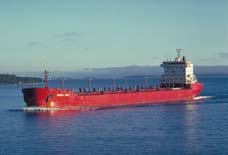|
Climate Change and Great Lakes Shipping and Boating Fishing, boating, and low cost waterborne cargo transportation have shaped the economic growth of the region for centuries. This shipping delivers iron ore/taconite, coal, grain, limestone, salt, and petroleum products to the Midwest. The Great Lakes-St. Lawrence water transportation system supports more than 30,000 jobs in the US and Canada. Business revenue and personal income resulting from the movement of cargo in the system tops $3 billion/year. Recent findings from the Great Lakes Regional Assessment suggest that increased water temperatures and evaporation could contribute to a lake level decline of approximately 1.5 to 3 feet on various Great Lakes within the next 30 years. What does that mean for the stakeholders who rely on using the Great Lakes for commercial and recreational purposes? With below normal precipitation and above-normal temperatures in 1998-99, lake levels have continued to drop as much as 6 inches. Lower lake levels mean ships cannot carry as much. Commercial carriers are very dependent on water depth in channel-ways and harbors. There are more than 4 million recreational boats are owned within the Great Lakes states. Michigan ranks as the top state for boat owners in the US. Serving these boat owners is a large network of marinas (over 1800 in Minnesota, Wisconsin and Michigan alone). Low water also makes it more difficult for recreational boaters. There is greater chance of damage when entering or leaving the water. There is greater risk of running aground in harbors, marinas, or while underway in lakes or rivers because of propeller, keel, or hull strikes on lake bottom, boulders or shoals. Boating and Shipping Assessment report (PDF) available here. |
|
||
